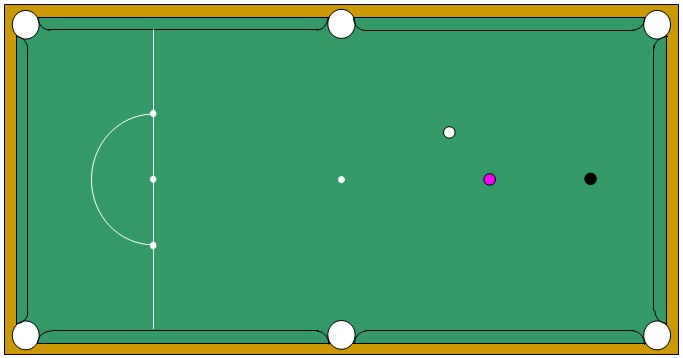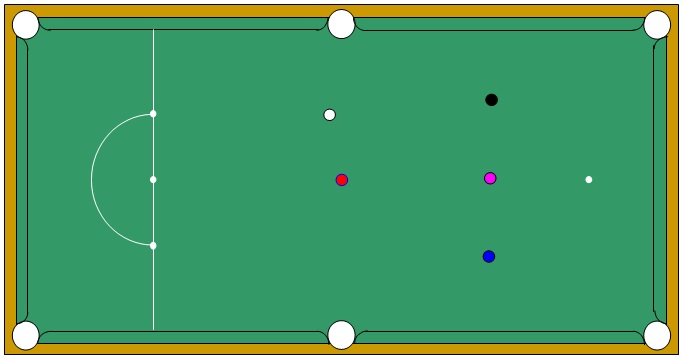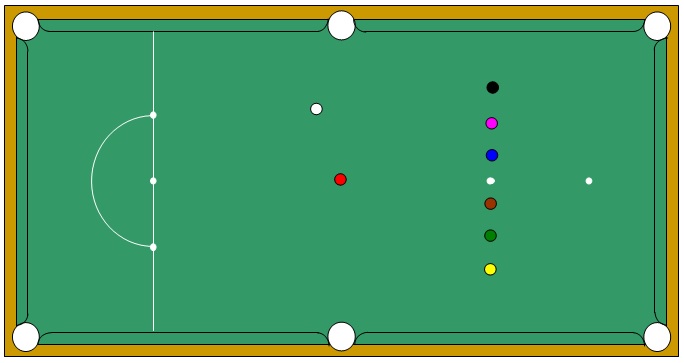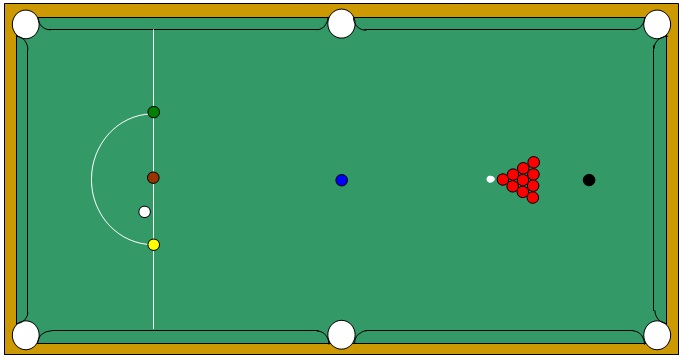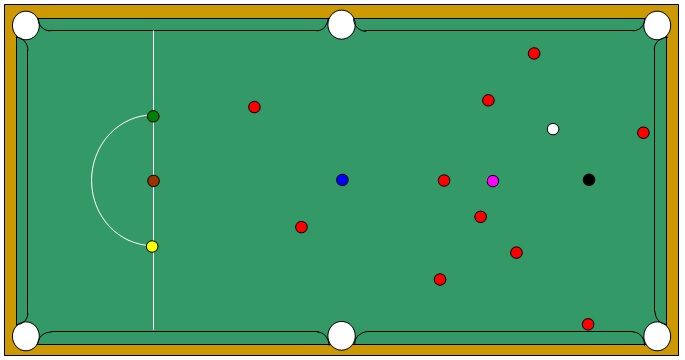FAST SNOOKER
The table is set by putting the colours on their spots and a red tight against the top cushion directly below the black.
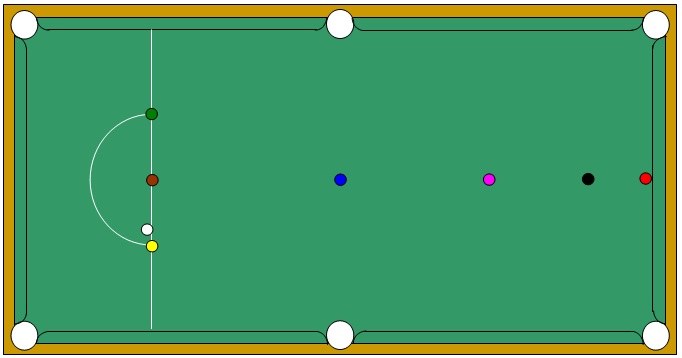
Rules
The colours are worth their normal values but the red is now worth ten points.
All fouls are four points and a foul is only made if no ball is hit by the cue ball or the cue ball goes into a pocket.
Person going first must aim to try and pot the blue.
After the opening shot any ball can be potted in any order. If two or more balls are potted in a shot then their total value is awarded.
The game ends when someone is in front by more points than the value on the table. And like normal Snooker if the Fast Snooker game goes to the final ball only one scoring shot is allowed.
BIG BREAK
 |
In the Big Break Challenge one ‘Joker’ can be taken so the points from a poor round can be forfeited and the round retaken. |
Rounds 1-3
Table Set Up – Form a pyramid of six reds below the pink spot as shown.
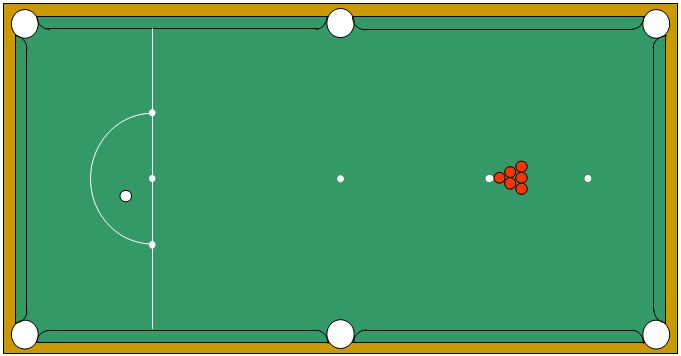
Break off by playing the cue-ball from the D to open the reds. Do NOT count any reds that are potted from the break off.
Round 1
The cue-ball can be positioned anywhere on the table (ball in hand) for each shot.
Award 1 point for each red potted.
Round 2
Up to four ball in hands can be taken.
Award 2 points for each red potted.
Round 3
Up to two ball in hands can be taken.
Award 5 points for each red potted.
Each round ends when a pot is missed or a foul is made!
Keep a running total of scores achieved.
Rounds 4 and 5
Table set up – Form a pyramid of the six colours below the pink spot as shown. Make sure to make the yellow the apex ball.
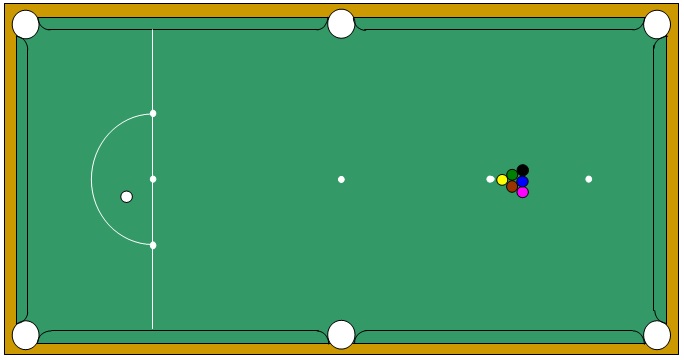
Break off by playing the cue-ball from the D to open the colours. Do NOT count any colours that are potted from the break off.
The colours must now be taken in order and each round ends when a pot is missed or a foul is made.
Round 4
Up to four ball in hands can be taken.
Award the normal colour values.
Round 5
Up to two ball in hands can be taken.
Award double points for each colour potted.
And points scored to the running total.
Rounds 6 and 7
Table set up – Form a pyramid of six reds below the pink spot then break open the reds from the D. Do NOT count any reds that are potted from the break off.
Now spot the colours. Below is an example of what the table could look like.
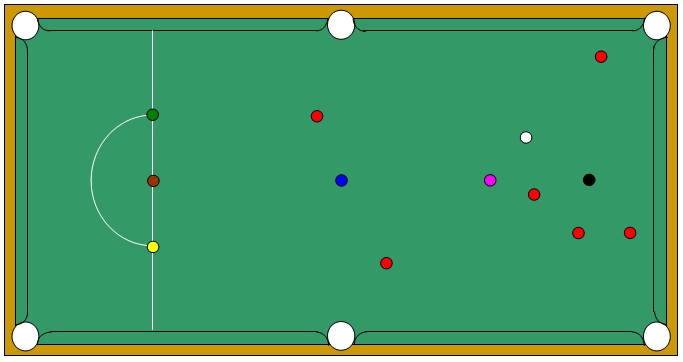
Attempt to clear the table. Each round ends when a pot is missed or a foul is made.
Round 6
Up to four ball in hands can be taken.
Award the normal values.
Round 7
Up to two ball in hands can be taken.
Award double points for each ball potted.
Winner is player with the most points.
CRICKET
Place the six colours in a triangle below the pink spot. Place the 15 reds around the colours to make a bigger triangle.
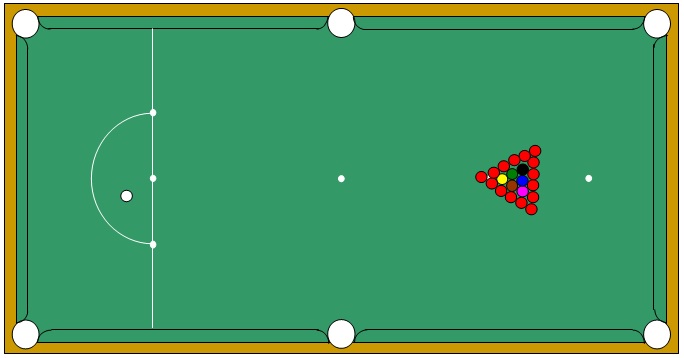
Rules
The bowler breaks and two balls must hit cushions. The bowler only plays reds, which are wickets and don’t score points. The batsman only plays colours, which are re-spotted when potted and the points value of each ball represent runs.
Once all the reds are potted, the innings ends and the players switch.
The batsman doesn’t have to nominate a colour and can play plants, ie, anything goes assuming he doesn’t hit a red first.
If the bowler fouls, it’s the same penalty as in snooker. If the batsman fouls, the bowler can remove one red from the table.
Following a foul, the incoming striker has the same options as in snooker, ie, free-ball if snookered or play again.
Superstar rules: once a player reaches a certain standard they cannot pot the same colour twice in a row.
CLEARING THE COLOURS – 105 POINTS CHALLENGE
Spot the pink and black.
Now with the cue-ball placed to start each go. Clear the colours from the pink, the blue, the brown, the green and to finish from the yellow.
Winner is the player who makes the most consecutive pots.
Here’s Cuestars Under-21 Silver player Dylan Smith achieving this challenge.
FINDING THE GAPS
Spot a red on the blue spot then line the high valued colours across the pink spot as shown.
With the cue-ball played from the same side of the table each time pot the red playing the cue-ball through the four gaps.
The high colours must not be contacted.
Winner is the player who finds the four gaps in the fewest shots.
CANNONS IN SEQUENCE
Put a red on the blue spot then line the six colours in order as shown.
With the red potted from the same side of the table each time, make a cannon on each colour in sequence.
Winner is the player who makes all the cannons in the fewest shots.
OPEN TABLE CHALLENGE
Spot the yellow, green, brown, blue and black then form a triangle of ten reds just below the pink spot as shown.
With the cue-ball played from the D break open the reds. Now spot the pink to complete the open table.
With the cue ball placed for the first shot only, clear the table.
Winner is the player who makes the highest break.

